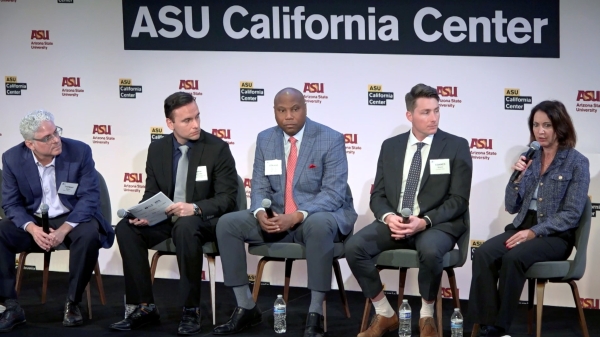The Trump administration recently announced that the Medicare trust fund will be depleted by 2026 — three years earlier than previous estimates — and the Social Security trust fund will be exhausted by 2034.
To better understand how this could impact the more than 60 million Americans who rely on these programs, ASU Now spoke to Swapna Reddy, clinical assistant professor in Arizona State University's College of Health Solutions.
Question: What does this announcement mean for the future of these programs, and for those who rely on Medicare or Social Security?

Swapna Reddy
Answer: The shortfalls refer to the trust funds that are designed to ensure full payment of both programs. It's important to understand that these announcements don't mean the entire Medicare and Social Security programs will be dissolved, but that without additional action, program benefits will have to be gradually reduced to meet financial constraints. The trust funds are a source of revenue for the programs, but not the sole source. The majority of the funding for these programs is derived from income and payroll taxes from current incomes. As such, even if the trust funds are totally depleted, 90 percent of Medicare and three-fourths of Social Security can be financed through dedicated revenue streams.
This is not the first time these programs have had their financial sustainability questioned, as reports of predicted Medicare funding exhaustion have been published intermittently since the program's implementation in 1965 and most recently under the Obama administration. The Obama administration responded through the Affordable Care Act, which put into place spending cuts and increased revenues that added an additional 10 years of sustainability to the Medicare program.
Efforts by Congress and the Trump administration through the 2017 tax law to reverse the efforts of the Affordable Care Act have reduced this 10-year projection by three years, to 2026. If new policies are not established to extend the longevity of Medicare and Social Security, these programs will not have the funding to continue performing as they have been.
Q: More than 60 million people are on Social Security, Medicare or both. What options will be available to those individuals if the funding for these programs runs out?
A: The projected years that Medicare and Social Security will have depleted funds represent when these programs will no longer be able to pay full benefits. For individuals relying on these programs, this means that they will not see an immediate absence of these programs, but they will not be receiving the same benefits or payment rates as program participants are currently.
In 2026, it is predicted that Medicare benefits will be reimbursed at 91 percent of their current rate and decrease to a reimbursement rate of 76 percent by 2039. For health insurance, there will still be the option for individuals over 65 to purchase supplemental plans to pay for any benefits not covered under Medicare.
Social Security projections predict that enrollee payments will be reduced by 25 percent, but that funding could be sustained at this rate for 75 years.
Although Medicare and Social Security have historically seen repeated threats to their funding sources, Congress has never allowed the complete bankruptcy of these programs. Due to their popularity among the public, it is most likely that policymakers will find a way to compromise to extend the longevity of both programs before funds deplete.
Q: Are there are policy changes or other government actions that could reverse the decline of these programs?
A: It’s important to understand that together Social Security and Medicare make up around 40 percent of the federal budget. Large cuts to "government spending" to offset large tax cuts will inevitably have an impact on the programs. It is a matter of opinion and ideology which approach one takes to address this issue.
There are many policy changes that could be put in place to reverse the decline of Medicare and Social Security, and policymakers are fiercely debating what actions to take. Two major overarching options are reducing overall health care spending or increasing revenue through taxpayers. These have become standard debate issues in our nation's struggle with our national identity on health care and health programs. In essence, most of us want the security that the programs provide, think we are entitled to it and don't want to pay more than we already do to sustain them. Considering the high cost of health care, the needs and size of our aging population, and prevalence of chronic conditions, the numbers simply don't add up.
The Trump administration and Seema Verma, current administrator of the Centers for Medicare and Medicaid Services, have advocated for budget cuts that would reduce payments to physicians and other health care providers. Past Republican administrations have pushed for the complete restructuring of Medicare or Social Security programs to perform more efficiently, and current Speaker of the House Paul Ryan has been a staunch proponent of a voucher-style program that would limit Medicare funding and encourage retirees to obtain private insurance.
Some Democratic legislators have supported the return of enforcing the often unpopular individual mandate, a provision of the Affordable Care Act that requires a tax penalty for individuals who do not purchase health insurance. The individual mandate will no longer be in effect beginning in 2019 and is expected to increase the uninsured American population and rates of uncompensated care within hospitals. Legislators from both parties can agree that healthcare spending should be reduced, but whether or not to increase revenue via taxpayers is an ongoing policy debate and will determine whether additional funding is allocated to sustain Medicare and Social Security beyond their expected depletion timeframes.
Top photo courtesy of Pixabay.com
More Law, journalism and politics

TechTainment conference explores the crossroads of law, technology, entertainment
What protections do writers, actors, producers and others have from AI? Will changing laws around name, image and likeness (NIL) eliminate less lucrative college sports programs?And what does…

How to watch an election
Every election night, adrenaline pumps through newsrooms across the country as journalists take the pulse of democracy. We gathered three veteran reporters — each of them faculty at the Walter…
Law experts, students gather to celebrate ASU Indian Legal Program
Although she's achieved much in Washington, D.C., Mikaela Bledsoe Downes’ education is bringing her closer to her intended destination — returning home to the Winnebago tribe in Nebraska with her…
